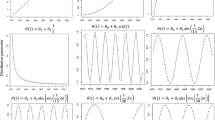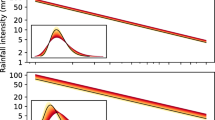Abstract
Traditional approaches to the analysis of extreme hydrological series are based on the stationarity assumption for the underlying processes, namely that the probability distribution of the hydrological variable does not change with time. Over the last decade however, a growing interest has arisen both from a scientific as well as engineering point of view, toward the development of tools able to cope with the apparent non stationary features (either natural or anthropogenic) observed in many hydrological processes. Though most of the works deal with extreme precipitation and floods, less attention has been devoted to modeling droughts under non stationarity paradigm. In the paper, a brief review of the available tools for modeling non stationary series is presented. An extension of such methodologies to drought lenght modeling is developed, taking into account the non stationary nature of the underlying series and/or of the threshold level used for drought definition. An example of application of the developed methods to four precipitation series in Sicily, Italy, exhibiting different degrees of trends is also presented.




Similar content being viewed by others
References
Abramowitz M, Stegun IA (1965) Handbook of mathematical functions. Dover Pubblications, Inc., New York
Agilan V, Umamahesh N (2017) Non-stationary rainfall intensity-duration-frequency relationship: a comparison between annual maximum and partial duration series. Water Resour Manag 31(6):1825–1841
Aissaoui-Fqayeh I, El-Adlouni S, Ouarda T, St-Hilaire A, et al. (2009) Non-stationary lognormal model development anf comparison with non-stationary gev model. Hydrol Sci J 54(6):1141–1156
Bonaccorso B, Peres D, Cancelliere A, Rossi G (2013) Large scale probabilistic drought characterization over europe. Water Resour Manag 27(6):1675–1692
Bonaccorso B, Peres D, Castano A, Cancelliere A (2015) Spi-based probabilistic analysis of drought areal extent in sicily. Water Resour Manag 29(2):459–470
Bowles D, James W, Kottegoda N (1987) Initial model choice: An operational comparison of stochastic streamflow models for drought. Water Resour Manag 1(1):3–15
Brockwell PJ, Davis RA (2002) Introduction to time series and forecasting. Springer Verlag, New York
Cancelliere A, Salas JD (2004) Drought length properties for periodic-stochastic hydrologic data. Water Resour Res 40(2):
Cancelliere A, Salas JD (2010) Drought probabilities and return period for annual streamflows series. J Hydrol 391(1):77–89
Coles S, Bawa J, Trenner L, Dorazio P (2001) An introduction to statistical modeling of extreme values, vol 208. Springer,
Cooley D (2013) Return periods and return levels under climate change. Extremes in a Changing Climate, Springer, pp 97–114
Delgado J, Merz B, Apel H (2014) Projecting flood hazard under climate change: an alternative approach to model chains. Nat Hazards Earth Syst Sci 14(6):1579–1589
Delgado JM, Apel H, Merz B (2010) Flood trends and variability in the mekong river. Hydrol Earth Syst Sci 14(3):407–418
Du T, Xiong L, Xu C-Y, Gippel C, Guo S, Liu P (2015) Return period and risk analysis of nonstationary low-flow series under climate change. J Hydrol 527:234–250
Duan K, Mei Y (2014) Comparison of meteorological, hydrological and agricultural drought responses to climate change and uncertainty assessment. Water Resour Manag 28(14):5039–5054
El Adlouni S, Ouarda TBMJ, Zhang X, Roy R, Bobée B (2007). Generalized maximum likelihood estimators for the nonstationary generalized extreme value model. Water Resour Res 43 (3)
Field CB, Barros V, Stocker TF, Dahe Q, Dokken DJ, Ebi KL, Mastrandrea MD, Mach KJ, Plattner G-K, Allen SK et al (2013) Managing the risks of extreme events and disasters to advance climate change adaptation: Special report of the Intergovernmental Panel on Climate Change
Fuller WE (1914) Flood flows. ASCE
Gilleland E, Ribatet M, Stephenson AG (2013) A software review for extreme value analysis. Extremes 16(1):103–119
Griffis VW, Stedinger JR (2007) Incorporating climate change and variability into bulletin 17b lp3 model. World Environmental and Water Resources Congress 2007: Restoring Our Natural Habitat, pp 1–8
Gül GO, Aşıkoğlu ÖL, Gül A, Gülçem Yaşoğlu F, Benzeden E (2014) Nonstationarity in flood time series. J Hydrol Eng 19(7):1349–1360
Haro D, Solera A, Paredes J, Andreu J (2014) Methodology for drought risk assessment in within-year regulated reservoir systems. application to the orbigo river system (Spain). Water Resour Manag 28(11):3801–3814
Katz RW (2013) Statistical methods for nonstationary extremes. Extremes in a Changing Climate, Springer, pp 15–37
Katz RW, Parlange MB, Naveau P (2002) Statistics of extremes in hydrology. Adv Water Resour 25(8):1287–1304
Khaliq M, Ouarda T, Ondo J-C, Gachon P, Bobée B (2006) Frequency analysis of a sequence of dependent and/or non-stationary hydro-meteorological observations: A review. J Hydrol 329(3):534–552
Kundzewicz ZW (2011) Nonstationarity in water resources - Central European perspective. J Am Water Resour Assoc 47(3):550–562
Li J, Wang Y, Li SF, Hu R (2015) A nonstationary standardized precipitation index incorporating climate indices as covariates. J Geophys Res Atmos 120(23):12,082–12,095 2015JD023920
Llamas J, Siddiqui M (1969) Runs of precipitation series. Hydrology paper 33. Colorado State University, Fort Collins, Colorado
López J, Francés F (2013) Non-stationary flood frequency analysis in continental spanish rivers, using climate and reservoir indices as external covariates. Hydrol Earth Syst Sci 17(8):3189
Mohammed R, Scholz M, Zounemat-Kermani M (2017) Temporal hydrologic alterations coupled with climate variability and drought for transboundary river basins. Water Resour Manag 31(5):1489–1502
Mondal A, Mujumdar P (2015) Return levels of hydrologic droughts under climate change. Adv Water Resour 75:67–79
Mood A, Graybill F, Boes D (1974) Introduction to the theory of statistics. McGraw-Hill, New York
Nalbantis I, Tsakiris G (2009) Assessment of hydrological drought revisited. Water Resour Manag 23(5):881–897
Prosdocimi I, Kjeldsen T, Svensson C (2014) Non-stationarity in annual and seasonal series of peak flow and precipitation in the uk. Nat Hazards Earth Syst Sci 14:1125–1144
Raff DA, Pruitt T, Brekke LD (2009) A framework for assessing flood frequency based on climate projection information. Hydrol Earth Syst Sci 13(11):2119–2136
Razmi A, Golian S, Zahmatkesh Z (2017) Non-stationary frequency analysis of extreme water level: Application of annual maximum series and peak-over threshold approaches. Water Resour Manag 31(7):2065–2083
Rossi G, Benedini M, Tsakiris G, Giakoumakis S (1992) On regional drought estimation and analysis. Water Resour Manag 6(4):249–277
Rossi G, Cancelliere A (2013) Managing drought risk in water supply systems in europe: a review. Int J Water Resour Dev 29(2):272–289
Russo S, Dosio A, Sterl A, Barbosa P, Vogt J (2013) Projection of occurrence of extreme dry-wet years and seasons in europe with stationary and nonstationary standardized precipitation indices. J Geophys Res Atmos 118(14):7628–7639
Salas JD, Obeysekera J (2014) Revisiting the concepts of return period and risk for nonstationary hydrologic extreme events. J Hydrol Eng 19(3):554–568
Serinaldi F (2015) Dismissing return periods!. Stoch Env Res Risk A 29(4):1179–1189
Sharma T (1997) Estimation of drought severity on independent and dependent hydrologic series. Water Resour Manag 11(1):35–49
Solomon S, Qin D, Manning M, Chen Z, Marquis M, Averyt K, Tignor M, Miller H et al (2007) Ipcc, 2007: summary for policymakers. Climate change, pp 93–129
Šraj M, Viglione A, Parajka J, Blöschl G (2016) The influence of non-stationarity in extreme hydrological events on flood frequency estimation. J Hydrol Hydromechanics 64(4):426–437
Stedinger JR, Griffis VW (2011) Getting from here to where? flood frequency analysis and climate1. J Amer Water Works Assoc 47(3):506–513
Strupczewski W, Singh V, Feluch W (2001) Non-stationary approach to at-site flood frequency modelling i. maximum likelihood estimation. J Hydrol 248(1):123–142
Sveinsson OG, Salas JD, Boes DC (2005) Prediction of extreme events in hydrologic processes that exhibit abrupt shifting patterns. J Hydrol Eng 10(4):315–326
Tsakiris G, Kordalis N, Tigkas D, Tsakiris V, Vangelis H (2016) Analysing drought severity and areal extent by 2d archimedean copulas. Water Resour Manag 30(15):5723–5735
Tsakiris G, Nalbantis I, Vangelis H, Verbeiren B, Huysmans M, Tychon B, Jacquemin I, Canters F, Vanderhaegen S, Engelen G, Poelmans L, De Becker P, Batelaan O (2013) A system-based paradigm of drought analysis for operational management. Water Resour Manag 27(15):5281–5297
Tsakiris G, Pangalou D, Vangelis H (2007) Regional drought assessment based on the reconnaissance drought index (rdi). Water Resour Manag 21(5):821–833
Vangelis H, Spiliotis M, Tsakiris G (2010) Drought severity assessment based on bivariate probability analysis. Water Resour Manag 25(1):357–371
Villarini G, Smith JA, Napolitano F (2010) Nonstationary modeling of a long record of rainfall and temperature over rome. Adv Water Resour 33(10):1256–1267
Villarini G, Smith JA, Serinaldi F, Bales J, Bates PD, Krajewski WF (2009) Flood frequency analysis for nonstationary annual peak records in an urban drainage basin. Adv Water Resour 32(8):1255–1266
Volpi E, Fiori A, Grimaldi S, Lombardo F, Koutsoyiannis D (2015) One hundred years of return period: Strengths and limitations. Water Resour Res 51(10):8570–8585
Wang Y, Li J, Feng P, Hu R (2015) A time-dependent drought index for non-stationary precipitation series. Water Resour Manag 29(15):5631–5647
Xiong L, Du T, Xu C-YB, Guo SC, Jiang C, Gippel C (2015) Non-stationary annual maximum flood frequency analysis using the norming constants method to consider non-stationarity in the annual daily flow series. Water Resour Manag 29(10):3615–3633
Zargar A, Sadiq R, Khan F (2014) Uncertainty-driven characterization of climate change effects on drought frequency using enhanced spi. Water Resour Manag 28(1):15–40
Author information
Authors and Affiliations
Corresponding author
Rights and permissions
About this article
Cite this article
Cancelliere, A. Non Stationary Analysis of Extreme Events. Water Resour Manage 31, 3097–3110 (2017). https://doi.org/10.1007/s11269-017-1724-4
Received:
Accepted:
Published:
Issue Date:
DOI: https://doi.org/10.1007/s11269-017-1724-4




